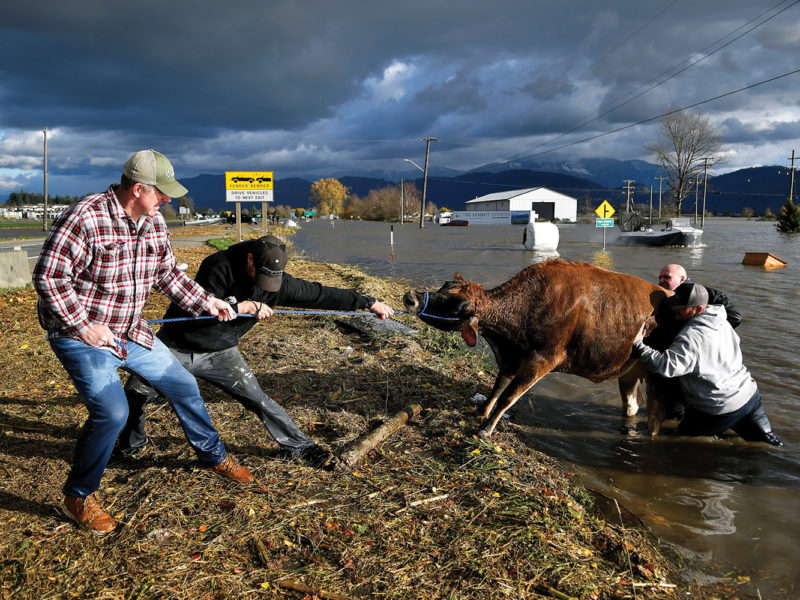VICTORIA – When flooding hit Sumas Prairie last month, years of efforts by the BC Dairy Association to prepare producers for disaster paid off.
Working with the provincial government, the association developed an emergency planning workbook for members. A template pulls together key information producers should have at hand in the event of an emergency, including a site plan, farm profile and contact list.
The association also oversees a buddy system that allows producers to shift cattle to a buddy farm when wildfires or floods approach, something that came in handy both during the recent floods and the summer’s wildfires.
Thousands of cattle were relocated, with 43 animals taking refuge in Agassiz at the property of BC Dairy chair Holger Schwichtenberg.
“It’s been amazing to watch the community come together to help each other out,” he says. “People rescuing cows by opening their barns or offering transportation and coming with trucks and trailers.”
The system is one he doesn’t take for granted. While his own farm has an emergency preparedness plan should a natural disaster strike, his buddy farm is in the Interior. Reaching it would have been impossible last month when more than 225 mm of rain triggered mudslides that shut down Hwy 7.
“My heart goes out to those who had to leave their farms behind,” he says.
This year’s extreme weather underscores the necessity of better preparation on the part of producers, strong partnerships and access to the right insurance and business risk management program coverage, says Graham Knox, director of the Emergency Management & Climate Change branch with the BC Ministry of Agriculture, Food and Fisheries.
Planning not only helps mitigate risks and ensures the safety of families and workers, especially for operations in remote locations, it also increases the resilience of operations during the recovery phase.
“At the most basic level, it’s about business continuity. Getting back and recovering as quickly as possible,” says Knox. “If you can prepare by assessing your hazards, preventing and mitigating, that’s going to mean, when those incidents arrive, the impact on you is hopefully avoided or significantly reduced. The potential losses or impacts to your business or how long it takes to get back up to speed is really influenced by having that … emergency plan.”
Preparing an emergency plan for large acreages, complex infrastructure, people and livestock may seem daunting, but resources are available to help with this process. BC Dairy’s workbook breaks down the planning process into bite-sized chunks, for example, making it easier for producers to plan.
“You don’t want to be overwhelmed by the prospect of building a plan,” says Knox. “Even a little action in terms of thinking and putting something together, can provide significant payback in the event of an emergency.”
The cost of preparedness is far less than the cost of response and recovery, he adds.
Knox suggests producers reach out to their respective sector associations to see if they have emergency planning workbooks. Provincial emergency management organizations also provide information, tools and resources to assist with planning. Different operations require different approaches, depending on size and complexity.
“There are different resources and complexities within operations. Even if you don’t end up with a big plan, just … (reviewing) the questions is a good first step,” says Knox. “We have some business consulting services available through one of our ministry programs to help producers go through their plans. Ag Safe can also work with and help producers.”
A farm’s emergency preparedness plan will be tailored to its operations. Similarly, producers need to know their own responsibilities with disaster strikes. These may include understanding the risks and types of disasters that occur in their area, training family members and workers on their emergency plans and testing it and building local networks to increase resiliency and provide mutual assistance, says Knox.
The province also has responsibilities in emergencies, including acting as a coordinating agency during livestock, poultry and plant disease events, developing and maintaining hazard-specific emergency management plans, and providing emergency education, outreach and resources for producers, producer associations, local authorities and First Nations, says Knox.
Next summer, the province will launch specialized tools to better prepare the agriculture industry for more extreme climate events. It recently allocated funding for two emergency response trailers to support livestock producers as well as associated training specific to agriculture and farm needs.
Producers can register for Premises ID and should always have their numbers on hand. This can facilitate communications with farmers in the run-up and aftermath of events, including notifications of incoming extreme weather events that could affect their land and animals.
“It’s almost a priceless registration for us right now, because we know exactly where registered farms are and how many animals they have,” says agriculture minister Lana Popham as staff continued to work last month to assist more than 1,100 farms under evacuation orders or alerts as a result of record rainfall.
Two-thirds of livestock producers and all supply-managed livestock premises are registered with the program, according to the province. A new Premises ID regulation under the BC Animal Health Act promises to make it mandatory in 2022.
But the development of more on-farm supports as extreme weather events become more common is critical. While weather impacts farm properties, farmers bear the financial cost of natural disasters, adding to existing levels of stress.
“The other big challenge for producers is the cumulative impact … the sense of being constantly under threat,” says Knox. “You’re affected by the 2017 wildfires and then the 2018 wildfires and then again in 2021. … Some people are starting to feel that in the Interior.”


 Province sets agenda for tree fruit future
Province sets agenda for tree fruit future